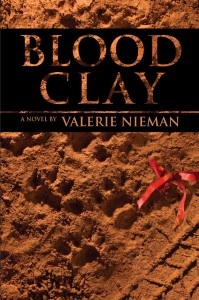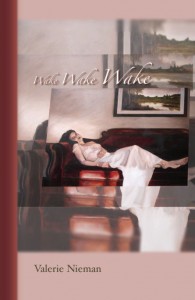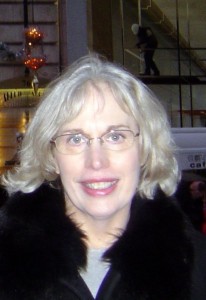Will Read for …

Press 53 published Val Neiman's gripping novel Blood Clay, a story about the challenge of courage and shades of belonging, set in North Carolina tobacco country
One of the great joys, and terrors, of being a writer is being asked to give readings.
Readings are a validation of our work and of our ability to project that work before an audience. When they go well, they provide a rush of reinforcement that can keep us writing through those bleak Februaries of thin inspiration.
Yet the reading is not about the writer. It’s about the book, most directly. But it is ultimately about the audience, and providing those people in the chairs with an enjoyable experience that will make them want to buy and read the book. This is the tao of readings.
I’ve been reading this year from Blood Clay, a new novel I call “two-thirds love story and one-third crime drama,” wrapped in a consideration of history both personal and societal. If that sounds like a challenge to present in 20 or 30 minutes, you are so right.
I recently appeared at McIntyre’s Fine Books in Fearrington Village, near Pittsboro. This is a great bookstore, offering a variety of reading spaces from intimate to huge (i.e. the Barn). I read in the “crime room” with crime scene tape, wonderful book posters, and a deep chair fit for Col. Mustard or Miss Scarlett! Best of all, McIntyre’s supports a rich calendar of literary offerings and has developed a great audience, well-read, engaged, and willing to pose interesting questions.
Choosing What to Read
I usually read three short selections from the novel – the first few pages of the first chapter, a few paragraphs from later in that chapter, and the first part of Chapter 3. I have other selections, depending on the audience. With a novel you can choose such bits and pieces to give a sense of the story as a whole, remembering that you want to engage potential readers, draw them in, raise but not answer their questions. You need to be careful not to start so deep in the book that you must provide a lot of explanation – it’s deadly to listen to a long-drawn account of who these characters are and what has happened before the writing we will hear.
I often read from my earlier poetry collection, which is always a pleasure – a palette of subjects, seasons, and tones from which to paint a portrait of the book. Toughest for me is reading short fiction. Read one story? Pieces of stories? Marjorie Hudson’s current book, Accidental Birds of the Carolinas, has stories linked by setting and theme, so she is able to read selections for four or five stories that tie together. We sometimes read as a team, exchanging bites from our books, with their similar themes of strangers in the South, love for place, and the joys and difficulties of relationships.
Limiting Your Time
Remember the wonderful readings you’ve attended, enchanted by the poet or writer? Remember the ones that became feats of endurance, the writer going on too long, your stomach growling and bottom welded to an uncomfortable chair? Seems like we remember the bad more than the good.
The biggest sin by an author is to keep the stage too long. “Just one more” poem can be one too many. Leave them wanting more, eager to read the book.
Only Connect!
Let the audience members feel like they are part of the celebration of your words. Ask questions. Talk about yourself and how your life is connected to these words – and ask how their experiences may dovetail with yours. It seems a bit corny, but this is something that stand-up comedians (“Anyone here from Philadelphia?”) and classroom teachers (Who are your favorite movie characters?”) have learned by trial and error. Participation, personal connection, buy-in, belonging – all ways of thinking about how to connect one-on-one with the people who are waiting for your words.
Making Your Venue Work With (Not Against!) You
It’s best is you can become familiar with the bookstore and where you’ll be reading well in advance of the day. You can head off problems if you know that you are planned to read with the coffee bar at your back – and the unsettling eruption of grinders and steamers. Noise is distracting, but so is light, if either you or your audience has to face into a sun-drenched window. Hot corners, drafty doorways, and traffic patterns across the reading area can generally be avoided with some discussion and rearrangement.
Dress for Success
Yes, even in the world of literature, there is a dress code. Not much of one, but I would suggest that your outfit not distract from the words. Clunky bracelets and heavy chains banging together, clothes that need to be tugged or held or adjusted, will get attention that would better be focused on your elegant sentences or scintillating images. Simple and comfortable styles will allow both you and your audience to relax and focus.
It’s Not One Size Fits All
Ideally, you will have a clear, strong voice that carries throughout the room, or a good microphone to help, though I will always remember hearing Jean Valentine, how her soft voice made you lean closer and closer, into the confidences shared in the poems.
If you are using a microphone, make sure it is adjusted to suit your height and your speaking level before the event begins. You want to have the microphone at a proper distance so that it amplifies rather than distorts.
All the World’s a Stage
If you are going to get up in front of people, “take ownership” of that!
You have to be willing to be a performer. Depending on your material, that may mean a willingness to be dramatic or to play a bit of the fool. Among the great readers I remember: Gail Galloway Adams, who would sing bits of ballads or hymns in her husky voice, and Joe Mills, whose self-deprecating humor meshes so well with the frequent but gentle humor of his poems.
You are a performer. Be prepared. Practice, know what you will read, mark it well – and be ready to make changes to your planned program if necessary.
The ultimate secret to reading? You will get what you give away. Give enthusiasm, give joy, give passion, give all the emotions that play across the surface of your prose like dappled light. And you will get readers who respond to your writing.
—
Val Nieman is a poet and a fiction author, living in central North Carolina, in the southeastern United States. Follow her on Twitter at @ValNieman. Like her Blood Clay Facebook Page. Subscribe to Valerie Nieman’s blog. Take a look at Val Nieman’s books on Amazon.com. And please, if you enjoyed or learned from her post here, leave a comment with a link back to your own blog or website.
Category: Contemporary Women Writers, Marketing Your Book, US American Women Writers, Women Writing Poetry


























At my very first reading, my leg shook so violently I had to hold on to the table. Mortifying. I hope it gets easier with practice!
Thanks for your note, Louise! I remember getting leg shakes, too. But it has gotten easier. Best wishes on your next reading!
What an encouraging post!–and, so fitting to my life at the moment. This Friday I am going to hear my writer-friend and former classmate speak at our school. I am hoping it will help me realize, “hey, I could do that, too!” Coupled with the great advice in this article, I think I’m in for an inspirational experience!
I’m lucky to have some theater training under my belt and I’ve used it many times when speaking in public about my books. I can’t imagine how terrifying it would be to face speaking in public without those tools in my arsenal.
My feelings exactly: Only Connect has been my mantra since my first book reading, taken from E. M. Forster’s character Margaret in Howards End. The work connects us all through language, deep feeling. We are lucky to be in such rooms, no matter how many people show up.
And thanks for the shout out, Valerie!
Val, this is all great advice that I hope I will be able to put into practice some day in the not too distant future.
I recently attended a few events at the Word Festival held at Aberdeen University (Scotland). I heard the fabulous Margaret Attwood read there and although she was on a stage before an audience of hundreds, she managed to engage each and every one of us. For her it was easier – she *IS* Margaret Attwood – but we can all dream about getting there some day.
Thanks for your practical advice, Val.
Nettie Thomson
http://www.nettiethomson.com
@NettieWriter
Very interesting and informative post Valerie!
Well I’m a long way from this point, but your post is so useful. And I’m definitely going to be using the time from now until I do actually get to read my writing (ahem!) to go and see other authors reading so I can find out what works and what doesn’t.
Thanks for sharing your experiences 🙂
Val, thanks so much for sharing your experience with author readings. Having just attended one of yours in the Raleigh area of North Carolina, where I heard first hand a bookstore manager say how well you engaged your audience, and how important that is, I’m glad to see you share your suggestions. Who’d have thought that in addition to your listeners, you also need to win the hearts of the bookstore event managers.
I especially loved seeing that you and fellow Press 53 author Marjorie Hudson are doing events together. With both of you writing about moving to the South, about belonging and place, there is added resonance in your joint events. As a global nomad with origins in Massachusetts, now living in the South, your work is deeply relevant. – Anora McGaha, editor